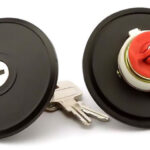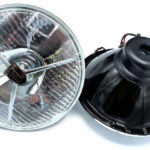Safety is always an important consideration for any club attending or running an event. Good planning and an awareness of the risks are important factors in ensuring that exhibitors and visitors have an enjoyable experience on the day.
One of the best examples of an Event Guidance Document is the one produced and used by the Military Vehicle Trust and recently updated by Tim Hawkes, MVT Events Manager.
We asked Tim about the background to the document and what safety issues vehicle clubs should consider when planning their own events…
Could you give me a bit of background to the MVT?
In 1968 a small group of Military Vehicle enthusiasts on the South Coast formed the Military Vehicle Conservation Group. Its success was such that in 1987 it became the Military Vehicle Trust – a charitable organisation that now has worldwide membership of over 6,200.
The early days saw the restoration of mainly World War 2 surplus vehicles used by farmers or commercially and then abandoned. Now, MVT members have vehicles from pre First World War to the present day, from bicycles to tanks and from just about every manufacturing country in the world.
Some members will spend years researching and restoring their vehicle whilst others are content just to buy and run a restored vehicle. All are proud of the standard of their vehicles and this is reflected in the frequent requests for vehicles for film and TV work.
The MVT has four regional contacts and 36 local areas holding informal monthly meetings that provide a forum for members to discuss just about any topic they want. Wherever you are, you can be sure there is another member who can help or who knows someone who can. Most areas organise social events, outings and participation in local shows.
As many members are ex-services, there are close ties with ex-servicemen’s associations. In particular many areas have close involvement with the Royal British Legions poppy appeal with members and their vehicles supporting the collection points.
The Trust has a very active club shop and offers a vehicle verification scheme with our DVLA authorization.
No club can prosper without a club magazine and we are justifiably proud of the reputation of our own magazine WINDSCREEN. Published six times a year, it contains articles and information, everything the Military enthusiast needs.
What process was involved in updating the guidance manual?
The existing safety officer was planning to step down and when I joined the Council of Management I had already got four years of experience running a reasonably large military vehicle show.
I had used the old version MVT event safety guidance document when I started out with Wicksteed at War, however with the experience I had gained I realised there were things missing from it and so suggested to the Council of Management I make some changes. This then turned from a few updates into a full rewrite.
How often do you plan to update the new version of the event guidance document?
The document has been updated already three times in the last six months. Once the changes are approved by the Council of Management the new documents is made available on the Internet.
Updates are made on the basis on incidents that take place at similar events, learning how we can make things safer. Updates are also made when members contact us with recommendations, for example a recent update regarding dogs at shows.
What changes in legislation have you seen since the first version (June 2010) of the event guidance document?
I was not involved in the document that long ago, however the requirements for risk assessments and meeting the needs of insurers have become tougher.
One of the biggest changes that we have had since the initial document is around the use of drones, and remotely controlled equipment. These are a potential minefield at large events and need to be policed carefully as you can easily fall foul of CAA regulations.
What changes in the approach to event organisation, management and safety have you seen since the first version (June 2010) of the event guidance document?
We all refer to risk assessment and Health and Safety as being the big thing that affects everything we do. However much of this is being driven by the requirements of insurers who are obviously trying to mitigate risk (or increase profit if you like).
We take the approach that the safety of all our members and the public at shows is paramount. What this means in practice is that any risk that may come up, whether it is in someone’s head or actually happens we put in a process to reduce that risk as close to zero as possible.
However, when we do this we look for ways of linking this up with other activities so that we are not piling rules upon rules. It is very important the vehicle owners can come to shows and have fun without having to worry about lots of rules.
The risk should be reduced by the organisers not the vehicle owners, having said that, increasingly vehicle owners are having to take more responsibility.
How useful is it to have an event guidance document when dealing with an insurance company, either looking for event insurance or dealing with a claim?
From our point of view the insurers require us to have the Event Guidance Document as it is the best practice guide for getting things right. Without it and the associated risk assessments we would not get our show insurance.
How useful is it to have an event guidance document when dealing with site owners, local authorities or applying for funding?
In my personal experience having the event guidance document supported by our insurance gives peace of mind to even the most risk adverse show organisers. It allows us to go to locations that others may not be able to. However this only works if our members follow the rules when they are at the show.
What would be the best piece of advice you would give clubs setting up and running a new event?
The answer to this is simple. Number one: make sure that the vehicle owners enjoy themselves and show off their vehicle. Number two: do everything with a safety mind-set, but do it with a positive safety mind-set. ‘How can we make this work?’ should be the key question on everyone’s lips.
If you ever find yourself saying “That will do” or “Don’t worry about it” then you are failing your members and the public.
What are the most common problems for clubs setting up an event?
The commitment for running any event starts 6 – 12 months prior to the event. I think that many organisers focus on their show too late and as a result miss key systemic issues, which, given a bit of time to think about could easily be solved.
What do clubs tend to overlook when planning an event?
In my experience three things get in the way of an event being safe or not.
- Lack of preparation and detail,
- Thinking health and safety is just a paperwork exercise, and
- Personal ego of the show organisers
The need to report a ‘near miss’ is often misunderstood. Why is it important?
Near misses are the most important source of information for improving processes and ensuring that it doesn’t become an incident.
We had a near miss at Wicksteed at War a few years back with a runaway tank. Since then all tracked vehicle owners are required to chock their vehicles once parked up. Easy to implement, easy to deliver and it totally removes the chance of this happening again.
People who feel uncomfortable about reporting near misses are actually putting the public in danger by not helping show organisers see the risks and prevent them.
Do you have any example or anecdote of how having an event guidance document has helped when planning an event?
As I have said earlier I used the MVT event guidance document to start my show six years ago. Without it I would have been completely lost in terms of having any degree of safety.
Also the land owners would not have allowed me to set up the show without that supporting documentation. I would never have known to double fence our arena if had not been for the event safety guidance document and thank goodness we did as we had a tank pick up an inner arena fence during a display; and with 2 metres between the two fences there was little risk to the public. Had there only been one fence it would have been a completely different story.
How do clubs get training to carry out a risk assessment?
The MVT are currently working on setting up training for their members, in things such as risk assessments, running a safe show, vehicle marshalling and understanding our event guidance document.
These are early days so we have not researched yet who may deliver this type or training or where to source it. However the Health and Safety Executive have some great material on risk assessments, what they are and how to complete them.
My view on risk assessments is if you think of a risk however ridiculous; write a risk assessment for it. It will make you see things in a different way, which is always a good thing.
Further Reading
Event Safety Guidance and Resources
Article originally published by ClubWorks [August 2016]









